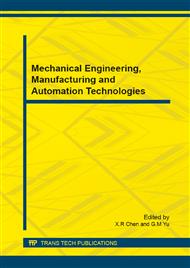p.164
p.173
p.178
p.182
p.190
p.194
p.198
p.204
p.209
Research on Green Design Overall Technology of Electromechanical Products
Abstract:
With the development of global industrial, electromechanical products enterprises create wealth for the mankind at the same time, but also consume a lot of resources, and cause serious environmental pollution. In the design stage, enterprises must consider to prevent environmental pollution, to save resources and energy. The whole life cycle of electromechanical product refers to design, manufacturing, transportation, sales, use, and recycling etc. Protection resources and environment is the whole life cycles core. Green design is from cradle to cradle. The technologies of green design are different from the traditional design which is only pay attention to function. It is not only to meet the needs of the people and solve the problem for the traditional starting point for the design, but also must to consider the use of natural resources, reduces types and quantities of pollutants, effective reuse, and reasonable cost of materials.
Info:
Periodical:
Pages:
190-193
Citation:
Online since:
December 2014
Authors:
Price:
Сopyright:
© 2015 Trans Tech Publications Ltd. All Rights Reserved
Share:
Citation:


